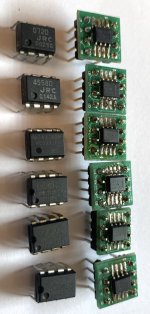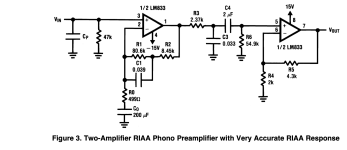It makes me wonder why tube preamps and amp sound so good given the low gain, and feedback, much higher noise levels and for power amps, relatively high Damping Factor, distortion & output impedance.
Maybe not having massive gain to lose with negative feedback and ridiculous slew rates and bandwiths for audio use are not prerequisites for excellent sound quality afterall?
Maybe not having massive gain to lose with negative feedback and ridiculous slew rates and bandwiths for audio use are not prerequisites for excellent sound quality afterall?
In reply to post #41
This is kind of out of the subject but, as I read here "Audio Power Amplifier Design Handbook" by D. Self, tube amps sound very inaccurate, but some people just love the high level of even harmonics. Some guys like blonds, some brunettes, it is a free country, right?
This is kind of out of the subject but, as I read here "Audio Power Amplifier Design Handbook" by D. Self, tube amps sound very inaccurate, but some people just love the high level of even harmonics. Some guys like blonds, some brunettes, it is a free country, right?
Really? The TS272/274 seem to sport 10mV worst voltage offset, not great. Voltage noise is a massive 30nV/√Hz according to the table, or a hideous 60nV/√Hz according to the graph(!). Very slow at 3.5MHz and 5.5V/us, hardly any gain (10V/mV) expect distortion high, especially at higher audio frequencies. According to the open-loop response graph the open loop gain is only 40dB, not 80dB as the 10V/mV figure would suggest. So two errors in the datasheet spotted at a first glance, sounds like a device to avoid really... Compare to a good CMOS opamp like the AD8656...
Kudos to @PMA for a truly eye-opening study.
I have been thinking about the downsides of having 140dB of open-loop gain, and PMA has found one: the amplifier is very sensitive to EMI!
For comparison, my discrete-transistor op-amps have an open-loop gain of 60dB. This precludes doing active RIAA EQ in one stage.
Ed
I have been thinking about the downsides of having 140dB of open-loop gain, and PMA has found one: the amplifier is very sensitive to EMI!
For comparison, my discrete-transistor op-amps have an open-loop gain of 60dB. This precludes doing active RIAA EQ in one stage.
Ed
LME49720 ?
Input Noise Density: 2.7nV/√Hz (typ)
– Slew Rate: ±20V/μs (typ)
– Gain Bandwidth Product: 55MHz (typ)
– Open Loop Gain (RL = 600Ω): 140dB (typ)
– Input Bias Current: 10nA (typ)
– Input Offset Voltage: 0.1mV (typ)
– DC Gain Linearity Error: 0.000009%
https://www.ti.com/lit/ds/symlink/lme49720.pdf
Input Noise Density: 2.7nV/√Hz (typ)
– Slew Rate: ±20V/μs (typ)
– Gain Bandwidth Product: 55MHz (typ)
– Open Loop Gain (RL = 600Ω): 140dB (typ)
– Input Bias Current: 10nA (typ)
– Input Offset Voltage: 0.1mV (typ)
– DC Gain Linearity Error: 0.000009%
https://www.ti.com/lit/ds/symlink/lme49720.pdf
LME49720 is the same device as LM4562. And, yes. Some LM4562 = LME49720 have higher popcorn noise than a typical device.
I don't know that it's any more susceptible to RFI than any other high-bandwidth opamp. I haven't had issues in that regard, but I also use EMI/RFI filters at the inputs of all my circuits.
Tom
I don't know that it's any more susceptible to RFI than any other high-bandwidth opamp. I haven't had issues in that regard, but I also use EMI/RFI filters at the inputs of all my circuits.
Tom
That's not necessarily a function of the high loop gain. It could be a simple function of the fact that modern BiCMOS processes are pretty darn fast. I've worked in processes where the BJTs had ft well into the GHz range ... and that was a decade ago. I seem to recall 100s of GHz but could be wrong on that.I have been thinking about the downsides of having 140dB of open-loop gain, and PMA has found one: the amplifier is very sensitive to EMI!
That's probably because the discrete devices are much larger and, thus, much slower than those in a modern opamp.The discrete transistor pre-amp does not need them.
Tom
Both high gain and bandwidth are leading to the EMI sensitivity. The LM4562 appears to be clipping internally. It is being tripped up by microvolts and gigahertz.
The 2N5210 datasheet says Ft=30MHz. It won't notice microwaves. The pre-amp can't clip with less than a millivolt input in open-loop.
Ed
The 2N5210 datasheet says Ft=30MHz. It won't notice microwaves. The pre-amp can't clip with less than a millivolt input in open-loop.
Ed
This thread:LME49720 is the same device as LM4562. And, yes. Some LM4562 = LME49720 have higher popcorn noise than a typical device.
I don't know that it's any more susceptible to RFI than any other high-bandwidth opamp. I haven't had issues in that regard, but I also use EMI/RFI filters at the inputs of all my circuits.
Tom
https://www.diyaudio.com/community/threads/surprising-op-amp-measurements.402190/
Here is my attempt to try a few op amps.
I built a prototype on a breadboard using the circuit in the second picture.
I tried the following 12 op amps (first picture).
JRC 072D
JRC 4558D
NE 5532
OPA 2132
OPA 2134
LM 4562
OPA 1662
OPA 1692
OPA 1602
OPA 1656
OPA 2156
OPA 1612
The noisiest op amps is JRC 072. All others are similar. OPA 1612 is the quietest.
Noisewise, with any of the op amps the prototype is quieter than the cartridge (AT-MONO3/SP) + vinyl.
Sonically can't make significant distinction, but OPA 1612 might sound best.
Thank you to all that made suggestions.
I built a prototype on a breadboard using the circuit in the second picture.
I tried the following 12 op amps (first picture).
JRC 072D
JRC 4558D
NE 5532
OPA 2132
OPA 2134
LM 4562
OPA 1662
OPA 1692
OPA 1602
OPA 1656
OPA 2156
OPA 1612
The noisiest op amps is JRC 072. All others are similar. OPA 1612 is the quietest.
Noisewise, with any of the op amps the prototype is quieter than the cartridge (AT-MONO3/SP) + vinyl.
Sonically can't make significant distinction, but OPA 1612 might sound best.
Thank you to all that made suggestions.
Attachments
I built a prototype on a breadboard using the circuit in the second picture.
moving coil
The gain is much too low for a moving coil cartridge, or is it a high output moving coil cartridge?
Edit: it is, and it is meant for playing shellac rather than vinyl: https://www.audio-technica.com/en-us/at-mono3-sp
Edit 2: 78's are usually not RIAA corrected, but have a correction that depends on the record manufacturer. Are you sure you need a RIAA amplifier rather than an amplifier with switchable correction time constants?
Last edited:
According to the link in post #58, it is meant specifically for shellac records. Records from the 1980's and 1990's are made of vinyl rather than shellac and require a much smaller stylus (microgroove). You could damage your records when you play them with a much too large stylus.
- Home
- Design & Build
- Parts
- Can anyone help me to find a decent opamp in DIP8 socket?

